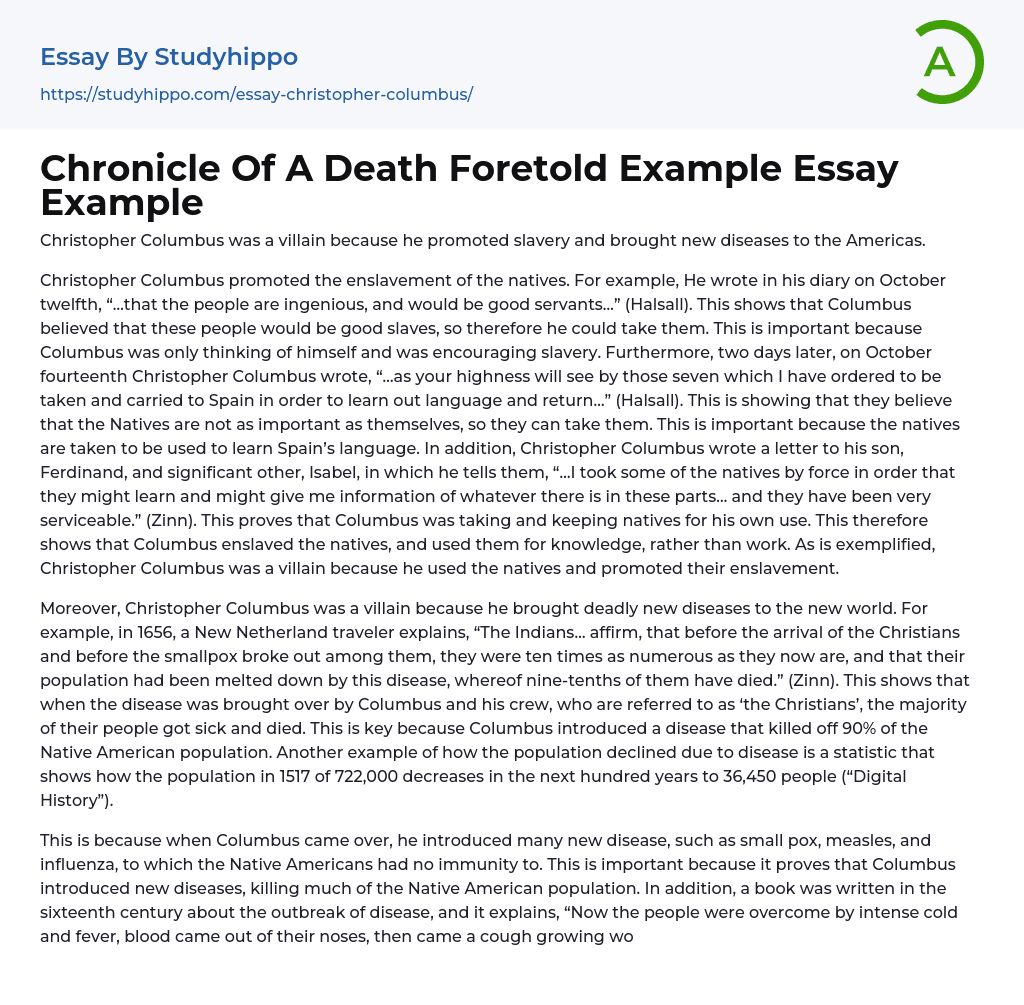Christopher Columbus is seen as a negative figure because of his support for slavery and the introduction of new diseases to the Americas.
Christopher Columbus supported the enslavement of indigenous people, as evident in his diary entry on October twelfth where he acknowledged their potential as servants (Halsall). This demonstrates Columbus' acceptance of enslaving the natives and prioritizing his own interests. Two days later, in another diary entry on October fourteenth, Columbus mentioned instructing seven natives to be taken to Spain for language acquisition and information gathering (Halsall). This illustrates their perception of the natives as individuals who could be exploited. It is important to note that these captives were primarily brought back to learn Spanish. Additionally, in a letter addressed to his son Ferdinand and partner Isabel, Columbus admitted forcefully tak
...ing some natives for acquiring knowledge about the region (Zinn). This reveals Columbus' intention to utilize and exploit the indigenous people for personal gain rather than solely enslaving them for labor. In conclusion, Christopher Columbus can be seen as an antagonist because of his enslavement of the indigenous population and exploitation of them for knowledge.
Christopher Columbus is considered a villain due to his introduction of deadly diseases to the new world. As per a 1656 account by a New Netherland traveler, Native Americans claimed that they were significantly more numerous before Columbus and his crew, referred to as 'the Christians', arrived along with the outbreak of smallpox. They attested that nine-tenths of their population perished from this disease. This directly connects Columbus and his crew to a substantial decline in the Native American population. Further evidence supporting this argument
includes a statistic indicating that the documented population of 722,000 in 1517 experienced a drastic decrease to only 36,450 individuals in the following century ("Digital History").
Upon reaching the Americas, Christopher Columbus introduced diseases such as smallpox, measles, and influenza to which Native Americans had no immunity. This resulted in a devastating impact on their population. A book from the 16th century graphically describes the severity of the outbreak, stating that people experienced intense cold and fever, bleeding from their noses, worsening coughs, twisted necks, and outbreaks of sores. The disease affected everyone in the area ("Module 01..."). This evidence emphasizes the wide-scale illness that afflicted Native Americans after Columbus's arrival and highlights his significant role in reducing their numbers. Consequently, Christopher Columbus is viewed negatively for introducing new diseases that caused numerous deaths among Native Americans.
Bibliography
- "Columbus Controversy." History.com. A;E Television Networks, 2013. Web. 23 Oct. 2013.
- "Digital History." Digital History. Digital History, 26 Oct. 2013. Web. 27 Oct. 2013.
- Halsall, Paul. "Medieval Sourcebook: Christopher Columbus: Extracts from Journal." Internet History Sourcebooks Project. Fordham University, Mar. 1996. Web. 29 Oct. 2013.
- "The Letter of Columbus to Ferdinand and Isabel." Prenhall. Prenhall.com, 2013. Web. 27 Oct. 1013.
- "Module 01: Demographic Catastrophe — What Happened to the Native Population After 1492?" Evidence Detail. Digital History Reader, 2013. Web. 30 Oct. 2013.
- Zinn, Howard. "Columbus, The Indians, and Human Progress." Columbus, The Indians, and Human Progress. History Is a Weapon, 2013. Web. 30 Oct.
2013.
- Slave Trade essays
- Christopher Columbus essays
- Exploration essays
- Pilgrims essays
- Simon Bolivar essays
- 1984 essays
- A Farewell to Arms essays
- A Good Man Is Hard to Find essays
- A Hanging essays
- A Lesson Before Dying essays
- A Long Way Gone essays
- A Rose For Emily essays
- A Separate Peace essays
- A Tale Of Two Cities essays
- A Very Old Man With Enormous Wings essays
- Adventures Of Huckleberry Finn essays
- Alice in Wonderland essays
- All Quiet on The Western Front essays
- Allegory of the Cave essays
- An occurrence at owl creek bridge essays
- Animal Farm essays
- Anthem essays
- Antigone essays
- Arthur Conan Doyle essays
- As I Lay Dying essays
- Atticus Finch essays
- Barn Burning essays
- Battle Royal essays
- Beauty and The Beast essays
- Beloved essays
- Boo Radley essays
- Brave New World essays
- Candide essays
- Castle essays
- Characters In Hamlet essays
- Characters In Romeo And Juliet essays
- Christmas carol essays
- Chronicle of a Death Foretold essays
- Cinderella essays
- Crime and Punishment essays
- Daisy Miller essays
- Death of a Salesman American Dream essays
- Desdemona essays
- Diary Of A Wimpy Kid essays
- Dracula essays
- Dubliners essays
- Emma essays
- Ender'S Game essays
- Ethan Frome essays
- Eveline essays




